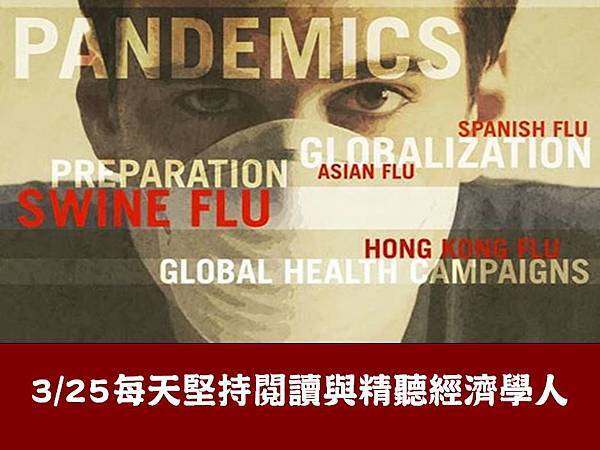
 今日主題:World economy-- Past and future tense 世界經濟--過去和未來時
今日主題:World economy-- Past and future tense 世界經濟--過去和未來時
 康康精選GRE&GMAT會考的主題,堅持每天精讀一定會進步的哦!!
康康精選GRE&GMAT會考的主題,堅持每天精讀一定會進步的哦!! MP3音檔 (按右鍵可下載聽):喜歡的同學,幫忙推或按讚哦~~
MP3音檔 (按右鍵可下載聽):喜歡的同學,幫忙推或按讚哦~~
http://xia2.kekenet.com/Sound/2016/…/ecol0325_1207489sN9.mp3
 只有音檔怎夠,聽不懂地方,不用怕,康康幫你準備好中英文稿了:
只有音檔怎夠,聽不懂地方,不用怕,康康幫你準備好中英文稿了:
 中英文稿:
中英文稿:
Pandemics-- An ounce of prevention
流行病--預防不足
Crises of infectious diseases are becoming more common. The world should be better prepared
傳染病導致的危機已經越來越常見,世界應該做好更周全的準備
ONE of the sobering lessons of the Ebola crisis was how ill-prepared the world was for such a deadly disease. It is terrifying to reflect on how the virus's advance was halted in the teeming city of Lagos thanks only to the heroism of a single doctor and because the place just happened to have the expertise needed to trace all of the first victim's contacts. Today the world is facing a worrying outbreak of Zika virus, adding to a growing list of diseases that includes SARS, MERS and bird flu.
埃博拉危機讓世界清醒地認識到,我們對於如此致命的疾病有多麼的束手無策。細思恐極的是,當病毒在人聲鼎沸的拉各斯肆虐時,唯一能暫緩疾病爆發的希望只能 落在一名勢單力薄“英雄醫生”身上,而這一切不過是因為拉各斯剛好擁有能追溯到第一位患者病情恢復的醫療資訊。如今,繼SARS、中東呼吸系統綜合征和禽 流感之後,世界又面臨著寨卡病毒的爆發,而這個名單還將越來越長。
This is the new normal. New infectious diseases are becoming more common. With more people on the planet, more roads and flights connecting everyone, and greater contact between humans and animals, this is only to be expected. Over half of the 1,400 known human pathogens have their origins in animals such as pigs, bats, chickens and other birds.
這是一個新常態。新型傳染病變得越來越普遍。隨著地球上人口日益增加,大量的公路和航班提升了各個地區的通達性,再加上人與動物的接觸越來越多,這樣的情形不可避免。人類已知的1400個病原體中,有一半以上都源自動物宿主,包括豬、蝙蝠、雞和其他禽類。
Pandemics and pandemonium
流行病與大混亂
When a new outbreak occurs, fear spreads even more rapidly than the virus. Politicians respond, rationally or not, with travel bans, quarantines or trade blocks. Airlines ground flights. Travellers cancel trips. Ebola has infected almost 30,000 people, killed more than 11,000 and cost more than $2 billion in lost output in the three hardest-hit countries. SARS infected 8,000 and killed 800; because it hit richer places, it cost more than $40 billion. Predicting these losses is hard, but a recent report on global health risks puts the expected economic losses from potential pandemics at around $60 billion a year.
當新的疫情爆發時,恐懼情緒傳播的比病毒更快。政治家們做出各種合理或不合理的反映:禁止出行、檢疫隔離和貿易封鎖。航線暫停,旅行者們取消出遊。埃博拉 感染了超過3萬人,致死1.1萬人,疫情最嚴重的三個國家因此損失產值超20億。SARS感染了8千人,致死800人,由於爆發在較發達地區,其造成的產 值損失超過400億。預測這些疾病導致的損失不容易,但最近一份關於全球健康危機的報告預計,潛在的流行病將導致每年約600億的經濟損失。
As the threat grows, so does the case for beefing up defences against disease. America's National Academy of Medicine suggests that just $4.5 billion a year (equivalent to about 3% of what rich countries spend on development aid) devoted to preparing for pandemics would make the world a lot safer. The money would strengthen public-health systems, improve co-ordination in an emergency and fund neglected areas of R&D.
隨著危機不斷升級,對疾病的防禦也應同樣加強。美國國家醫學研究院表示每年僅需投入45億美金(相當於富有國家花在發展援助上的3%)在流行疾病防控上,世界便會變得安全許多。資金的投入將會用於加強公共衛生體系,提高研發部門在應對突發情況以及資金短缺的協調性。
Many of the investments to prepare for pandemics would bring broader benefits, too. Stronger public-health systems would help fight such diseases as tuberculosis, which reduces global GDP by $12 billion a year, and malaria, which takes an even bigger toll. But the priority should be to advance vaccines for diseases that are rare today, but which scientists know could easily become pandemics in the future: Lassa fever, say, Crimean Congo haemorrhagic fever or Marburg.
在流行疾病的防控上注入更多的投資會帶來更多的好處。每年僅在防治肺結核病上,全球GDP減少了120億美金,而瘧疾則耗費更多。若公共健康體系建立完 善,將有利於防治肺結核等疾病,但首要的是去研製疫苗去防治現今極其罕見,但又被科學家們聲稱今後極易大流行的疾病,比如拉沙熱,克裡米亞剛果出血熱,或 者瑪律堡。
Better sharing of data would help (see article). More important is funding and a review of who has liability if firms rush vaccines or drugs to market. The initial development and early-stage testing of vaccines for the most likely future pandemics would cost roughly $150m each. Drug firms have little incentive to invest in a vaccine that may never be used. For these firms even later-stage testing when a pandemic breaks out is tricky. The drug industry spent $1 billion on Ebola and took on liability risk, yet never made a profit. The same companies may not be so willing next time. To encourage drug firms to play their full part during an emergency, governments need to set out how they will share the burden.
若能更好地共用資料,那將會大有裨益(另見文)。更為重要的是提供資金,還有當公司把疫苗或者藥品推向市場時需審查責任人。即便是未來爆發可能性最高的流 行病的防控疫苗,在處於初步發展與早期檢測階段時,也要耗費大約1.5億美金。因此醫藥公司沒有動力去投資開發未來可能都不會被使用的疫苗。對於這些公 司,一旦疫情爆發,後期的疫苗測試也很難對付。醫藥行業花費了10億美金在埃博拉上,同時承擔了責任風險,然而從未獲利。沒有公司會願意虧本第二次。為了 鼓勵醫藥公司在疫情時期充分發揮自己的作用,政府需要明確自己將會如何替他們分擔責任。
Since the financial crisis, banks have been required to hold more capital in order to lower the risk of economic contagion. The world spends about $2 trillion annually on defence. Investing in health security is a similar form of insurance, but one with better returns.
自金融危機後,為了降低經濟危機蔓延的風險,銀行已被要求持有更多資本。全球每年共花去大約2萬億美金在防治疾病上面。在衛生安全上投資類似於購買保險,但是會取得更好的收益。


 留言列表
留言列表
